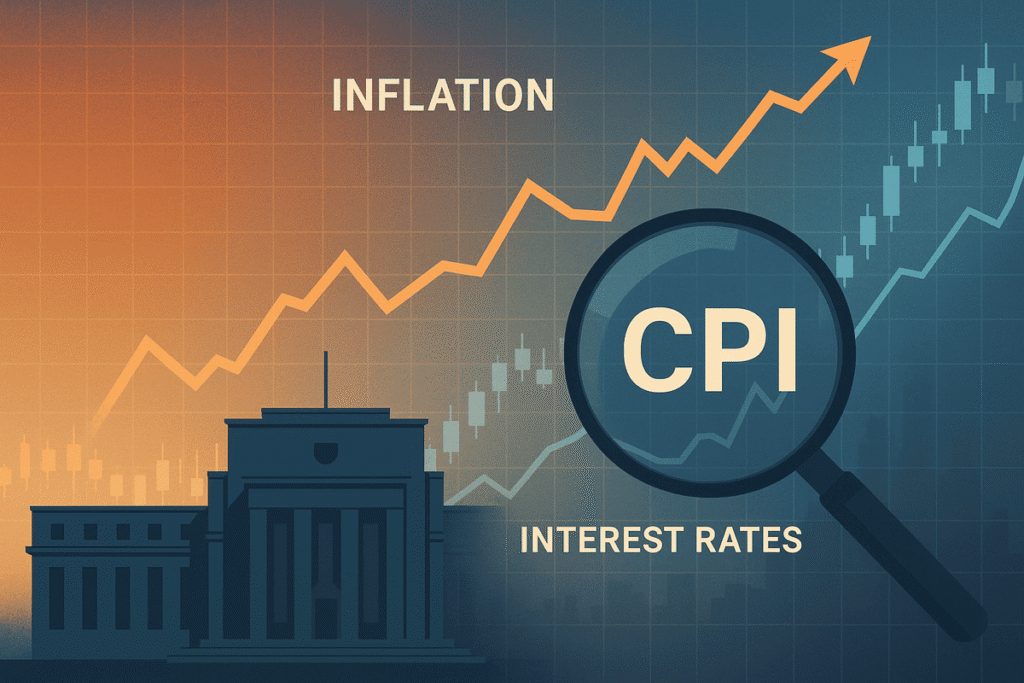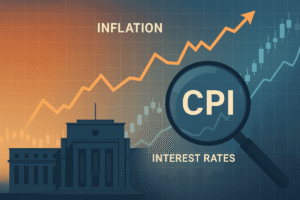
1. Recent inflation snapshot
The latest reading for the Consumer Price Index (CPI) in the United States signals that inflation remains elevated, though with signs of moderation. For September 2025, the year-over-year inflation rate stood at 3.0%. Core inflation (excluding food and energy) also rose 3.0% over the same period.
Core inflation (excluding food and energy) also rose 3.0% over the same period. Looking ahead, the Federal Reserve Bank of Cleveland’s now-cast model projects for November 2025 a CPI increase of around 2.97% year-over-year, and a monthly rise of ~0.30% for headline CPI.
2. Key drivers of inflation
Food & beverages: The food index increased by 3.1% year-over-year in September, with food-at-home rising 2.7%.
Energy: The energy index rose 2.8% over the 12 months ending September, driven by higher electricity and natural gas prices.
Core services (excluding housing): Inflation in this category is still elevated, reflecting services such as lodging, airfares, and household furnishings.
Shelter/rent: The housing component (“owners’ equivalent rent” & rent of primary residence) continues to exert upward pressure, albeit at a slower pace compared to previous years
3. Economic outlook & central-bank implications
With inflation running around 3% and above the Federal Reserve’s 2% target, the Fed is likely to maintain a cautious stance. Indeed, recent commentary emphasises that while inflation is coming down from its post-pandemic highs, the pace of decline remains uneven and risks remain tilted upward.
From a macro-perspective:
- The labour market remains relatively robust, although growth has softened.
- Consumer demand remains resilient, which bodes for inflation persistence.
- Risks such as energy price volatility, supply-chain disruptions, or renewed fiscal stimulus could push inflation higher in the near term.
4. Forecast: What to expect for November 2025 and beyond
Based on current data and modelling: For November 2025, headline CPI is expected to land near 2.9%–3.0% year-over-year, with monthly inflation around 0.25–0.30%. (Cleveland Fed now-cast: YoY 2.97%, MoM 0.30%.)
- Core inflation may remain around ~3.0% YoY, as underlying price pressures in services and shelter persist.
- Into Q4 2025 and early 2026, inflation should gradually edge toward the 2.5%–2.8% range, provided there are no major shocks.
- If energy prices spike or wage growth accelerates, upside risks could push inflation back above 3.0% or higher.
- For the Fed: given this trajectory, interest-rates may remain elevated for longer; any cuts would depend on clear signs of inflation moving sustainably closer to 2%.
5. What this means for consumers & markets
- Consumers: While inflation is lower than its peaks, real wages may still feel squeezed if price rises remain above historical norms. Costs of housing, food, and services remain the main drag.
- Markets: Inflation readings near 3% will keep markets alert — stronger-than-expected inflation could hinder asset-price gains and keep the U.S. dollar relatively supported; weaker inflation might increase speculation of policy easing.
- Businesses: Firms will remain mindful of input cost pressures and may hesitate to raise long-term pricing until inflation trends become more stable.
6. Key take-aways
- Inflation in the U.S. has moderated but remains above target; headline CPI ~3%, core inflation ~3%.
- Key pressure points: shelter/housing, food & services.
- Forecasts suggest inflation near 3.0% YoY in November, with gradual easing ahead barring major shocks.
- The Fed is likely to remain vigilant: inflation still too high for comfort, so policy may stay restrictive for a while.
- For consumers & markets: moderate inflation is “better” than high inflation, but until inflation gets closer to 2%, uncertainty remains.
The content of this article reflects the author’s opinion and does not necessarily reflect the official position of Webmile | Markets [A propriety of SingleDot Technologies]. The material published on this page is provided for informational purposes only and should not be considered as the provision of investment advice. According to copyright law, this article is considered intellectual property, which includes a prohibition on copying and distributing it without consent.
This forecast is based on the Elliott Wave Theory. When developing trading strategies, it is essential to consider fundamental factors, as the market situation can change at any time.
Expert Elliott Wave Analysis
We Help to identifies impulsive and corrective phases, helping traders predict price movements. By recognizing these natural market cycles, traders can identify trends, reversals, and ideal entry points, improving their trading precision and overall decision-making across different financial markets.













